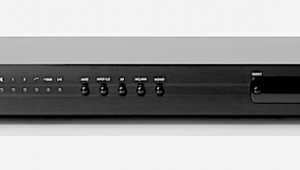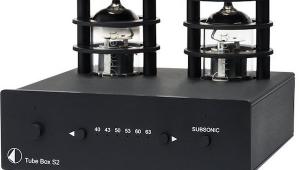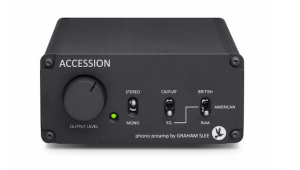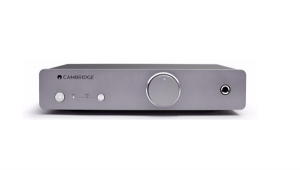I would have guessed, that you head for solid state MC-pre, because of lower noise and better fit to modern expensive cartridges. Isn't the Ypsilon VPS-100 a tubed design? (I myself don't trust anything else - only tubes, resistors, caps, transformators, wire and speaker drivers).
Pro-Ject’s MM/MC Phono Box RS Is A Chronic Overachiever

After spending a great deal of time with the $999 Phono Box RS and optional Power Box RS Phono battery pack, I’m happy to add my endorsement of this impressively well made, unusually feature-packed, great sounding product.
The Phono Box RS is a fully balanced, dual-differential, dual mono MM/MC phono preamp housed in a substantial chassis milled of aluminum that offers a full feature set unusual at this price point and its “on-the-fly” front panel mounted resistive loading knob is unusual at any price point.
In addition to the large knob that produces loading from 10 ohms to 1200 ohms, front panel controls include a mute switch, gain choices of 40dB, 50dB and 60dB (single ended) and 46dB, 56dB and 66dB (XLR/balanced out), a choice of RIAA or DECCA equalization (the later only for pre stereo era FFRR DECCA/London mono LPs) and a switch that lets you choice between the variable loading front panel knob and a fixed load set via a back panel dipswitch panel.
In fixed mode the dipswitch panel lets you choose between 47Kohms for MM use and 10 ohms for low internal impedance MC cartridges. Capacitive loading for MM cartridges is also set via the dipswitch panel, with choices of 100pF, 200pF, 220pF, 300pF, 420pF and 520pF (pF equals picofarads).
The rear panel also includes both single-ended RCA and balanced XLR inputs and outputs, a switch to choose between RCA/XLR inputs and outputs (if you run balanced outputs, Pro-Ject includes RCA to XLR adapters for single-ended RCA phono leads) and a subsonic filter (12dB@20Hz).
Unusual at this price point are the solid chassis mounted RCA jacks. And yes, if you have two turntables one with RCA and one with XLR terminated tone arm wiring, you can connecte both simultaneously and switch between them via the back panel mounted switch.
A “Walwart” powers the unit unless you opt for the $799 Power Box RS Phono, a battery pack-based power supply that runs the unit off of rechargeable batteries and automatically switches to “mains” power when the battery is depleted.
At the heart of the Phono Box RS is an Analog Devices SSM2019 chip uses as the input stage and Linear Technology’s LT1010 chip used as a high current buffer stage. These are low noise devices that help the Phono Box RS achieve impressively black backgrounds even at 60dBs of gain with a very low output MC cartridge.

Smooth, Rich Sonics
The sound produced by the “wall-wart” powered Phono Box RS is unmistakably smooth, warm and rich without at all sounding closed in or restricted on top, though there are airier and more expansive top ends to be had elsewhere. At this price point, however, the usual price to be paid is some grain, brightness or sizzle, all of which the Phono Box RS does not produce.
Deep, extended and powerful bass is among the unit’s strongest suits though it is not a fully articulated or expressed as you can get from far more expensive phono preamps.
I drove the Phono Box RS with a variety of cartridges more expensive than are likely to be used with it, including the Lyra Etna, Atlas, Atlas SL and Titan i MC cartridges as well as with the Ortofon A-95, and Miyajima Labs Zero and Premium BE mono cartridges.
Among the records played were Blake Mills’ highly recommended Heigh Ho (Verve B0021196-01) a double 180g LP with deluxe “Tip-on” gatefold packaging pressed at RTI and recorded at Ocean Way Studio B.
I admit to being a knucklehead who for some reason thought the guy was a country artist because of his name. Instead, this is a record that almost defies categorization, though Mills is a guitarist. Let’s for the sake of categorization in a phono preamp review to say he’s a cross between Ry Cooder and Jeff Tweedy? That hardly suffices, but it’s better than nothing.
The record is superbly recorded, whether to analog tape or to a computer and it features ultra-deep bass (Don Was on stand-up double bass on some tracks) that the Phono Box RS reproduces with impressive authority regardless of price.
The record also features a very deep, well developed soundstage with good instrumental focus and events occurring deeply within the stage that this phono preamp does a really fine job of expressing.
Jim Keltner is on drums throughout and while the drums have more sizzle and definition on more expensive phono preamps, they are surprisingly well expressed through the Phono Box RS.
Switching to classical music, while in Bulgaria I was treated to a performance by the Sofia Symphony Orchestra that included Lalo’s “Symphony Espagnole”, a version of which had recently arrived from Analogue Productions performed by Henryk Szeryng and the Chicago Symphony Orchestra conducted by Walter Hendl (RCA LSC-2456) so of course I opened and played it with no reference with which to compare it both as a reissue and as reproduced through my system.
The violin’s presence between the speakers was three-dimensional, with a pleasing and honest sheen, though not as airy and light as I later heard it through the fifty times more expensive Ypsilon VPS-100 silver edition phono preamp that I’m still paying off. Not surprising, but the Phono Box RS’s rendering of the violin and the orchestra was plenty involving tonally, spatially and dynamically.
Before swapping out the “wall wart” for the battery power Power Box RS ($799) I played one of my old standbys for transients, overall presence, staging and space, The Modern Jazz Quartet European Concert (Atlantic 2-603) a double LP set I’ve been playing since the early ‘60s (yikes!).
This one I know really well! Yes, the Phono Box RS lost some of the hall air and space, John Lewis’s piano was somewhat softened on the transients and Connie Kay’s drums were not quite as sharply drawn as I’m accustomed to, but honestly, had I not known, I’d have thought I was listening to a far more expensive phono preamp and that’s before installing the batter supply. The biggest clue that this was a moderately priced phono preamp was that when Milt Jackson was not playing vibes on the right channel, the lack of air and space produced the sensation that the right channel was dead.
The Power Box RS Phono
This box, sized and built to the same high standard as the Phono Box RS itself, fully isolates the Phono Box from the A.C. line using Lithium Polymer batteries, one for each channel, to provide about four hours of use. Once the battery drains to certain level the Power Box automatically connects to the A.C. to charge the battery. While the benefit of being off the grid is temporarily lost, the preamp still runs off of the battery, which acts like a filter bank to produce better sound than were the unit running off of the standard “Wal Wart”—or at least that’s the claim.
It didn’t take long to hear the benefits of the Power Box RS Phono. It produced greater transparency, blacker backgrounds that greatly improved low level detail resolution, deeper bass and even more sense of the hall on that MJQ record. The improvement was across the board and not at all subtle. If you buy the Phono Box RS and later add the battery supply, make sure it’s returnable if you don’t hear the improvement. I doubt you’ll be returning it.
Conclusion
The Pro-Ject Phono Box RS is a remarkably well-constructed, uniquely featured MM/MC phono preamplifier that offers for $999 fully balanced, dual-differential performance, low subjective noise and rich, fully bodied sonics. It’s easy to recommend except under one circumstance: if you’re looking for something to add brightness and/or “crispness” (and there’s nothing wrong with either depending upon from where you’re starting), the Phono Box RS might not be the best choice, though your choice of cartridge might also give you those qualities, even with the Phono Box RS.
Adding the $799 Power Box RS takes the performance to a higher level and brings the total to $1798. At that price point I’d take a serious listen to the Liberty Audio b2b, which as I recall its sound, produces faster, cleaner transients and perhaps snappier rhythm’n’pacing and greater transparency. That said, for $999 I can’t think of anything that beats or approaches the Pro-Ject Phono Box RS in terms of features and build quality and it competes sonically with everything I’ve heard at or near its price point.
Input impedance: 10Ω or 47kΩ (Rear Panel Selectable)
Loading Options: 10-1200Ω (Front Panel adjustable) )
Capacitance options: 100, 200, 300, 420 or 520pF
Gain Settings: )
RCA: 40, 50 or 60dB)
XLR: 46, 56 or 66dB)
S/N Ratio: 80dB (91dB@IEC-A) )
THD: <0.019%)
RIAA accuracy: ±0.3dB (20-20kHz) )
Subsonic Filter: -12dB @ 20Hz)
Inputs: RCA(pr) & XLR(Pr) )
Output: RCA(pr) & XLR(Pr) )
Output impedance: 50Ω)
Power supply: )
Input: 120VAC@60Hz)
Output: 2x18VDC@300mA)
Dimensions: 8.1x2.9x8.3" (WHD) )
weight: 4.5Lbs, without PSU
- Log in or register to post comments



Sirs: I never cease to be amazed by the amount of technology and money dedicated to searching vinyl grooves for information, the very source of which is limited by the ability of a cutting head to put the information in the groove in the first place. In 35 years I haven't been able to locate a test of these mysterious instruments in the major music journals. Should we spend $250,000 for a table, arm, cartridge and step up device if the cutting head cost $750? Count me skeptical in Woodland Hills.

The "mysterious instrument" is your ears. Seek a quality, well-setup analog rig--not it does not have to cost $250K, a well-put-together $15K total cost system will do just fine--and give it a couple of hours of your attention. Nothing missing and no mystery.

The instrument is the cutting head. What is the capability of the cutting head vs. the equipment used to retrieve the information it placed in the groove? LOL, what are you, a teenager?

I must admit that I don't write as well as Winston Churchill although I do have a copy of his History of the English Speaking Peoples here in my office. The frequency response of the Neumann SX-74 is impressive. I only wrote to inquire whether a comparison of the cutting equipment has been made to the state-of-the-art retrieval equipment. After that, you attacked me and then this other fellow who said LOL in the subject line attacked me. Now you're dropping F bombs? Methinks thou dost protest too much!

You took it personal, but it is not a personal attack. I am just stating a simple fact. The missing piece is your experience of an actual quality vinyl setup. There would be no point if asking this question if one has already answered it by experience. Many people, including myself, have had the privilege. And no I am not a teenager, though the suggestion is flattering. And no, I have not been a vinyl fanatic all my life. I own a few thousand CDs and enjoy some recordings on that format that are not available otherwise. However, if one has the opportunity to listen to a good pressing of a good tape recording on a quality setup, the question becomes pointless. My own system provides me with that experience everyday. But a memorable day with Harry Weisfeld at his home brought the opportunity of comparing vinyl vs reel-to-reel vs digital in some of the best sounding, cost-no-object, equipment around. There is no cutting head limitation to speak off, unless you are talking about a modern, digitally buffered cutting head. But that would be like saying vinyl sounds bad because of your experience a Fisher-Price turntable.
Everyone is entitled to their taste. You may prefer one sound or another. But the resolution of vinyl is way above CD format and any commercial, consumer available digital format to date. Easy proof is that you can actually hear the difference in a vinyl mastered from a hirez digital. I have several 24/96 records that sound decent, but I can easily hear the difference in quality. But the proof is I test with visitors. Play a few high quality analog records and then switch to hirez digi records (without their knowledge of course) and immediately get disapproving commentary.

See above comments regarding MF's attack.I surrender!

Why do we need to test what our ears can hear for themselves?

I have done a lot of experimenting with DACs of various degrees. I currently have a very musical DAC I really like. It's a highly custom modified DAC that uses an AKM chip, which I greatly prefer over others (like Sabre). What I found is the more I move "up" the DAC ladder from my DAC, it starts to get "perfect" beyond what is natural to me.
The analogy I use is TVs. I really like my LCD projector & TV. When I start to move "up" the ladder in TVs to something like 4K or LED, it gets so pristinely clear that is only natural to something like an owl. Well, while that picture is considered "technically superior", I don't want to see like an owl, I want to feel like I'M seeing it.
Conversley, as I go up the ladder in my vinyl rig, the sound keeps getting closer to the way it sounds if I'm listening to it live. Call it "added distortion" if you want. Whatever the reason, it sounds more natural to me.
Additionally, many people prefer the ultra clear picture of an LED or 4K TV. The same holds true with digital vs. vinyl. Many like the ultra pristine clarity. It's really OK to be in either camp. The folks here that are vinyl lovers prefer what they hear over what they experience listening to digital.

Hi Michael, Thanks for the excellent review! I'm a dealer for Pro-Ject, but haven't heard the Phono Box RS, so I appreciate your review. Any thoughts on a comparison to a perennial (and widely acknowledged) favorite in the price range, the Phonomena II+ (which uses discrete circuitry)? Another good one at the price point is the new Rogue Triton, if you've not heard it.
Galen Carol
Galen Carol Audio

I think I mentioned privately I'd gotten ahold of the Phonomena II+. If you were closer, I'd drop it off so you could give it a listen. I think it's pretty good so far (it has gotten excellent reviews) but I do find it to have a bit of background noise. I don't know if battery power would help reduce that or not--some of the faint background noise in components is caused by the "switching" noise in a rectifier, and I don't expect a top-grade rectifier or filtering in a wall wart.
I actually had it narrowed down to the Pro-Ject Tube Box DS and the Phonomena II+. If the Tube Box DS is as good as this Phono Box RS, I might be willing to try one out, provided I could get one on loan from a dealer to hear in my own setup.

I'm looking to pull the trigger in the near future on the RPM 10 Carbon, and wasn't aware of the Project gear reviewed here. I've had the 9.1 table for over a decade and have really enjoyed it. It will be kept. But I'm looking forward to a fun step up, and this Phono Box RS with battery pack for consideration afterwards sounds like a possible great match for 10 Carbon. My speakers are pretty revealing on the top end, so I'm not after brightness or crispness. Fabulous review. I'm not one for the technical jargon, and honestly I don't understand a lot of it. I don't need to when reviews like this explain things for me in "listening" terms. What I do understand is my own appreciation for listening to better sound. BTW who doesn't like sound (pardon the pun) of that Blake Mills record too? I'll have to keep an eye out for it.

I have listened to your rips for years, you have been very generous in sharing, they are obviously better than CD.

vinyl is so much more than the digital domain! The vinyl experience starts with the purchase, the opening, the jacket, the sleeve, the record itself, the weight, the look. I have Pearl Jams "no code' which is a gate fold and then opens again to 2 ft x 2ft with various 12x12 pics and booklet. cd's need not apply

Slightly off topic: Short of buying a turntable with two arms or using two turntables, what do you recommend to get non-stereo mono reproduction? A phono preamp with a mono switch or a preamp with one? Thanks.

A mono switch on the phono preamp would be better. A stereo signal is encoded on an LP as a middle-side signal: the lateral groove modulation is the middle signal (mono) and the vertical groove modulation is the side signal (difference signal). On a mono LP, any vertical groove modulation is just noise. So if you're playing the mono LP with a stereo cartridge, you want to mix the outputs to have only the mono signal. A mono switch on the phono preamp would accomplish this, but channel imbalances through the phono preamp would make a mono switch on the line stage preamp less effective. Many phono stages lack a mono switch, which would limit your choices. An alternative would be a pair of Y adapters. Connect the turntable output cables to a 2-female to 1-male Y adapter, which mixes the two channels to mono. Connect that to a 1-female to 2-male Y adapter so you can feed the mono signal to both inputs of your phono preamp.

Thanks for the info. I have noticed that few phono preamps have mono switches. I'm considering a Rega RP-10 with their Apheta 2 cartridge. Their IOS phono preamp does have a "mono function" but the $7k price will probably prevent me from going that route. The Y adapters are an excellent idea although it would be a something of a pain to have to replug things when switching between mono and stereo LPs.

Hey Mikey, thanks for the great review. How does it compare to the Rega, which is a similar price point in NZ. Thanks.

Michael you have a lot more patience than I do with people asking stupid questions. Are you going to Axpona this year?

Hello Michael,
How would you compare this one against the Lehmann Audio Black Cube Statement SE.
I use that phono amp with a Lyra Argo i cartridge on a Linn LP12 with a Ittok IV2 tonearm. Thanks in advance.

Specifically why Decca's curve was chosen as the 'pre-RIAA' setting.

Henryk Szering seemed to use "Symphonie Espagnole" as his calling card. I have the (much) later recording on Philips with the Monte Carlo Opera Orch.

I'm impressed, though I think the absence of a mono switch is silly. I've heard the best LCR units, which are great. But, affordable transistor gear keeps getting better, and cheaper. I wouldn't be at all surprised if you could create a better sounding budget analog front end, than one based purely on the price tag (the worst analog sound I've ever heard at a high end show was at CES, and the whole rig was well above $100K). It's getting insanely easy to get good sound on a tight budget, even if it takes a little strategery to pick the right pieces.
Thanks for an interesting review.
Regards,
Phillip

I 've tested this device a couple of years ago. Already owing an RPM 9.2 turntable, I was expecting something really good from Project Audio at this price point. And it was good. That's for sure. I totally agree with the qualities described in this review, except for the involving part. To be more precise, that was the reason that I rejected it. I found it quiet, detailed, with a wide and deep sound stage but more or less somewhat lifeless.
Many things have changed in my setup since then, so maybe I should give it another try sometime.

Another good find from music used for review. The Spotify version is nice but I'll search for a vinyl version. Love these sounds! Thanks!

Ifi iphono2 or the Pro-ject with the wall wart?
I'll be using this with a variety of MM and MC carts.

Hi guys,
I bought a Pro-Ject RPM 3 turntable recently, and wondering if I should go with a new Pro-Ject Phono Box RS MM/MC Phono Preamplifier (777 USD) or with a new Lehmann Audio Black Cube SE II MM/MC Phono Preamplifier (1050 USD).
Thanks a lot!
Matthieu
P.S. Also asked this question here: https://www.analogplanet.com/content/lehmann-audio-black-cube-se-ii-mmmc....


















































